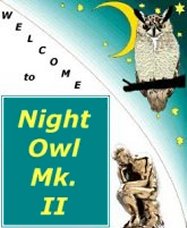|
MARK L. BAKKE'S
 Created with Allaire HomeSite 4.0 Last Update: 24 Oct 99 Return to "Designated Hitter" essay Back to Philosophy page Please feel free to E-mail me with your own comments on this issue or on anything else included in my Philosophy of Life section. Debate is good!
Please report any problems with this page to the
Webmaster!
|
|
REPLY #14 TO
"DESIGNATED HITTER"
Boldfaced statements are parts of the original essay (or a subsequent reply) to which the respondent has directed his comments.
Italicized/emphasized comments prefaced by (R) are those of the respondent and are presented unedited. My replies appear under the respondent's comments in blue text and are prefaced by my initials (MB). (R) I'm an archtraditionalist (no turf, no dh, no interleague play, and baseball is properly enjoyed only on radio). The symmetry of baseball lies in the fact that the critical defensive players (pitcher and catcher) are often the worst offensive players. The DH upsets this. It also burns out pitchers' arms early. Besides, for 10 million bucks a year, a pitcher with a 4.50 ERA could learn how to bunt. (MB) Unfortunately, one can't make a case for any claim that the DH rule contributes to overworked pitching arms. To demonstrate this, it would be necessary to show that American League pitchers pitch more innings and throw more complete games than do their National League counterparts. The stats for the just-concluded 1999 season, however, tell a much different story. The American League leader in innings pitched for the 1999 season was David Wells (231.2 IP). Four AL pitchers pitched at least 220 innings with the top 10 in IP averaging 219 IP. These pitchers averaged 6.61 innings per game. David Wells also led the AL in complete games with 7 and the top 10 totalled 50 complete games. In the National League, the IP leader for 1999 was Randy Johnson (271.2 IP). Seven different NL pitchers threw more innings than David Wells. In fact, the average for the top 10 was 236.2 IP -- fully five more innings than Wells. Those top 10 NL pitchers averaged 6.90 innings per game. Johnson also led the NL in complete games with 12, with Curt Schilling tossing 8, and Pedro Astacio completing 7 games. The top 10 threw a combined total of 56 complete games. Only one American League pitcher, Jamie Moyer (7.12 IP/game), averaged at least 7 innings per game. Five National League pitchers averaged over 7 IP/game with Johnson going 7.74 IP/game and Schilling 7.50 IP/game. Remember, also, that Schilling still ranks near the top of these stats despite losing a fair amount of the season to injury. It is clear, therefore, that the majority of the hardest-working pitchers in baseball are in the National League -- the non-DH league. This should quash the argument that the DH leads to overworked pitchers. This is not a single-season aberration, either. Since 1977, there have been 7 pitchers who have thrown 300+ innings in a season. Five of those were National League pitchers. The load on pitchers has been in decline since the inception of the DH rule. During the period 1961-1976, 8 of the top 12 single-season totals in complete games and 9 of the top 14 single-season totals in innings pitched happened *before* the DH rule was adopted. No pitcher has thrown more than 21 complete games in a season since 1985. There seems to be absolutely no evidence to support a case that the DH rule leads to overworked pitchers and plenty to suggest that National League pitchers work harder than their American League counterparts.
Created with Allaire HomeSite 4.0 .......... Last Update: 24 Oct 99
E-mail: mlbakke1@bakkster.com Earthlink Network Home Page |